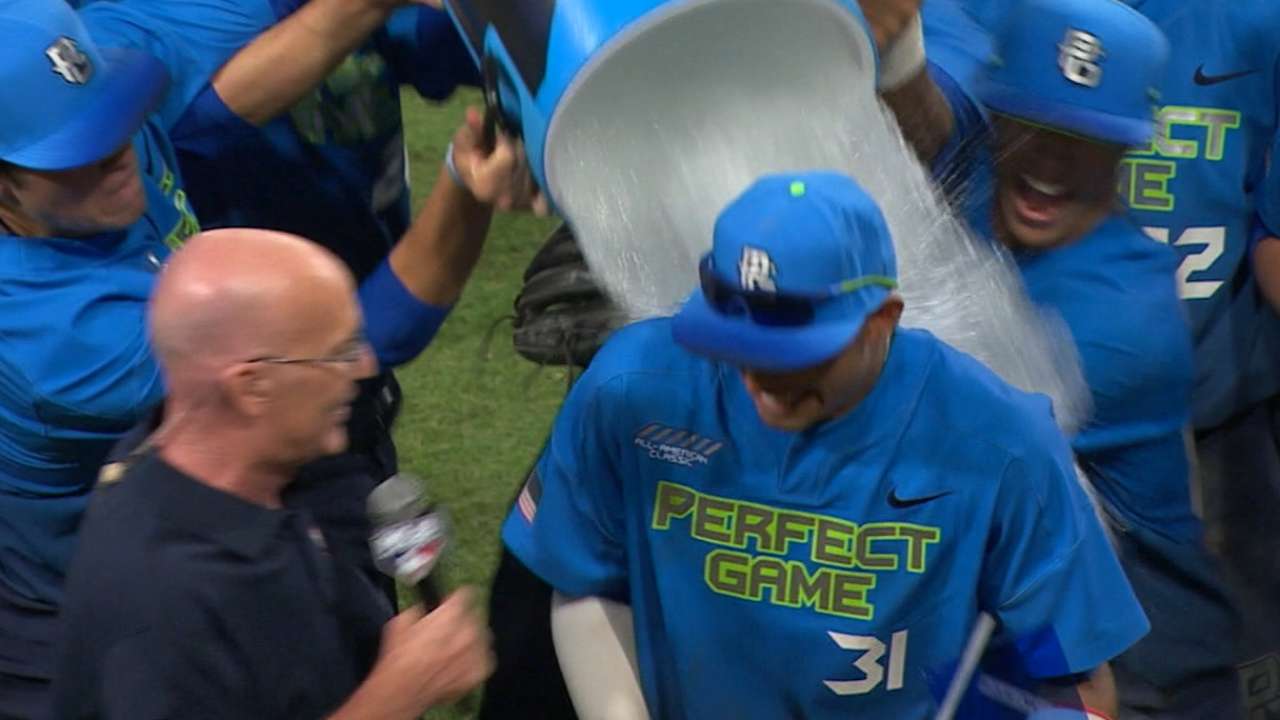
19. San Francisco Giants: OF Heliot Ramos, Leadership Christian Academy (P.R.)
Callis: I saw Ramos put on an absolute show at the Under Armour All-America game at Wrigley Field last summer. He has one of the better power-speed combinations in the Draft, but there are more mixed opinions on him than most of the players taken ahead of him. Some teams saw him as a first-round talent, while others worried about his hitting ability.
from mlb.com
http://m.mlb.com/news/article/235976306/mlb-draft-pick-by-pick-selections-analysis/?partnerId=ed-11582400-997508893
Draft: Pick-by-pick, first-round analysis
MLB.com Draft and prospect expert Jim Callis analyzes every pick from the first round.
ROUND 1
1. Minnesota Twins: SS Royce Lewis, JSerra Catholic (Calif.) HS
Callis: In a late decision, the Twins went with Lewis after strongly considering Louisville's Brendan McKay with the top choice. While it might have been a surprise to some, he's a legitimate No. 1 overall pick. He was in the top tier of five players in the mix for most teams at the top of the Draft. He has the best combination of tools of anyone in the Draft -- including elite speed -- and has a real knack for squaring up the ball.
1. Minnesota Twins: SS Royce Lewis, JSerra Catholic (Calif.) HS
Callis: In a late decision, the Twins went with Lewis after strongly considering Louisville's Brendan McKay with the top choice. While it might have been a surprise to some, he's a legitimate No. 1 overall pick. He was in the top tier of five players in the mix for most teams at the top of the Draft. He has the best combination of tools of anyone in the Draft -- including elite speed -- and has a real knack for squaring up the ball.

2. Cincinnati Reds: RHP Hunter Greene, Notre Dame (Calif.) HS
Callis: This is the guy the Reds wanted. And even though he would have been a mid-first round pick as a position player, he's definitely a pitcher for Cincinnati. He has one of the quicker arms we've ever seen in the Draft era, and his fastball - which has been clocked as high as 102 mph -- is among the best ever among amateur hurlers.
Callis: This is the guy the Reds wanted. And even though he would have been a mid-first round pick as a position player, he's definitely a pitcher for Cincinnati. He has one of the quicker arms we've ever seen in the Draft era, and his fastball - which has been clocked as high as 102 mph -- is among the best ever among amateur hurlers.
3. San Diego Padres: LHP MacKenzie Gore, Whiteville (N.C.) HS
Callis: Gore is my favorite player in the Draft. I would have taken him No. 1 if it were my pick. He's an athletic left-hander who can show you a 92-96 mph fastball, plus curve, and flash you a plus slider and changeup. He's also a very good two-way player in a Draft loaded with them. It's the first time since 1990 that the first three overall picks were all high schoolers.
Callis: Gore is my favorite player in the Draft. I would have taken him No. 1 if it were my pick. He's an athletic left-hander who can show you a 92-96 mph fastball, plus curve, and flash you a plus slider and changeup. He's also a very good two-way player in a Draft loaded with them. It's the first time since 1990 that the first three overall picks were all high schoolers.
4. Tampa Bay Rays: 1B Brendan McKay, University of Louisville
Callis: It's appropriate that McKay went fourth because that's also where Dave Winfield went in 1973, and Winfield is the only better two-way prospect in Draft history. I like him more as a position player and the Rays were the first team at the top of the Draft that preferred him that way. He was announced as a first baseman on the Draft broadcast, but I heard the Rays may give him a chance to do both. Stay tuned.
Callis: It's appropriate that McKay went fourth because that's also where Dave Winfield went in 1973, and Winfield is the only better two-way prospect in Draft history. I like him more as a position player and the Rays were the first team at the top of the Draft that preferred him that way. He was announced as a first baseman on the Draft broadcast, but I heard the Rays may give him a chance to do both. Stay tuned.
5. Atlanta Braves: RHP Kyle Wright, Vanderbilt
Callis: Wright, who was rumored to be the front-runner to go No. 1 as recently as a week ago, offers the best combination of floor and ceiling at the top of the Draft. He's a future front-line starter who should get to Atlanta very quickly. Interesting that after all the talk of clubs cutting deals -- which could theoretically cause top prospects to fall -- the consensus five best players went with the first five picks.
Callis: Wright, who was rumored to be the front-runner to go No. 1 as recently as a week ago, offers the best combination of floor and ceiling at the top of the Draft. He's a future front-line starter who should get to Atlanta very quickly. Interesting that after all the talk of clubs cutting deals -- which could theoretically cause top prospects to fall -- the consensus five best players went with the first five picks.
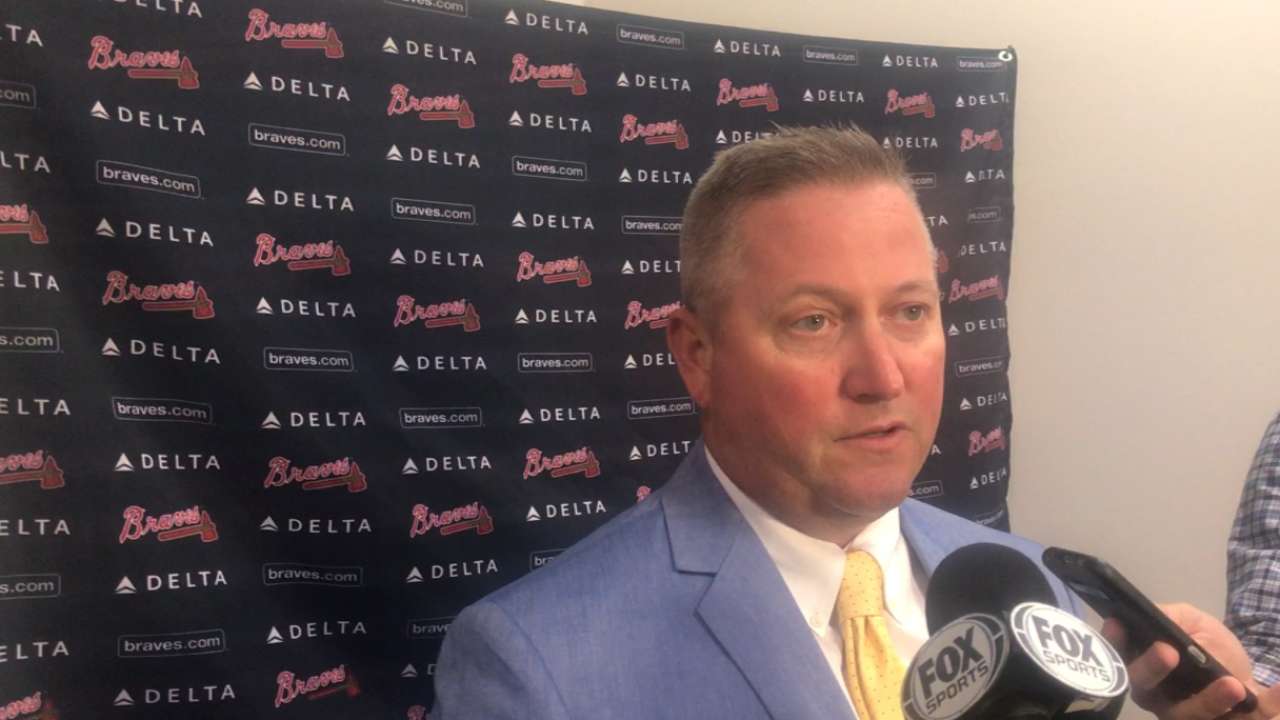
6. Oakland Athletics: OF Austin Beck, North Davidson (N.C.) HS
Callis: He has come a long way in a year after tearing up his knee in the North Carolina state playoffs during his junior year. He doesn't have a long track record on the showcase circuit -- at least compared to some of the other top prospects -- but he has one of the best combinations of tools in this Draft. He has raw power, good speed and a chance to stick in center field.
Callis: He has come a long way in a year after tearing up his knee in the North Carolina state playoffs during his junior year. He doesn't have a long track record on the showcase circuit -- at least compared to some of the other top prospects -- but he has one of the best combinations of tools in this Draft. He has raw power, good speed and a chance to stick in center field.
7. Arizona Diamondbacks: 1B Pavin Smith, University of Virginia
Callis: It was no secret that the D-backs would probably wind up with one of the two University of Virginia hitters, and they opted for the more potent bat with Smith, as opposed to the more athletic Adam Haseley, an outfielder whom Pipeline ranked as the No. 10 prospect in the class (we had Smith at No. 8) and that went with the very next pick. Some clubs thought Smith's combination of hitting ability and power made him the best offensive player in the Draft.
Callis: It was no secret that the D-backs would probably wind up with one of the two University of Virginia hitters, and they opted for the more potent bat with Smith, as opposed to the more athletic Adam Haseley, an outfielder whom Pipeline ranked as the No. 10 prospect in the class (we had Smith at No. 8) and that went with the very next pick. Some clubs thought Smith's combination of hitting ability and power made him the best offensive player in the Draft.
8. Philadelphia Phillies: OF Adam Haseley, University of Virginia
Callis: Another two-way player, Haseley was a pitching hero at the 2015 College World Series when the Cavaliers took home the title, but he'll be purely a center fielder as a pro. He stands out as a college up-the-middle player in a Draft that's thin in that regard, and is one of the best pure hitters available. Haseley and Pavin Smith are the first position players from the same college to both go in the top 10 since Oklahoma State's Monty Fariss (No. 6 overall) and Robin Ventura (No. 10) in 1988.
Callis: Another two-way player, Haseley was a pitching hero at the 2015 College World Series when the Cavaliers took home the title, but he'll be purely a center fielder as a pro. He stands out as a college up-the-middle player in a Draft that's thin in that regard, and is one of the best pure hitters available. Haseley and Pavin Smith are the first position players from the same college to both go in the top 10 since Oklahoma State's Monty Fariss (No. 6 overall) and Robin Ventura (No. 10) in 1988.
9. Milwaukee Brewers: 2B Keston Hiura, UC Irvine
Callis: Hiura was a late-riser in the week before the Draft, getting talked about with the Braves at No. 5 and the A's at No. 6 before going ninth to Milwaukee. He has dealt with some elbow issues that might lead to Tommy John surgery, but it wouldn't require the same kind of rehab that it would if he was a pitcher. But even if that happens, the payoff once he's fully healthy is huge: He is perhaps the best pure hitter in the entire Draft and he plays in the middle of the diamond.
Callis: Hiura was a late-riser in the week before the Draft, getting talked about with the Braves at No. 5 and the A's at No. 6 before going ninth to Milwaukee. He has dealt with some elbow issues that might lead to Tommy John surgery, but it wouldn't require the same kind of rehab that it would if he was a pitcher. But even if that happens, the payoff once he's fully healthy is huge: He is perhaps the best pure hitter in the entire Draft and he plays in the middle of the diamond.
10. Los Angeles Angels: OF Jordon Adell, Ballard (Ky.) HS
Callis: This is a classic high-risk, high-reward pick. Adell has the best combination of power potential, speed, and arm strength in the Draft. There are some questions about his swing-and-miss tendencies, which is why he didn't go even higher. But if he hits, he'll be a star.
Callis: This is a classic high-risk, high-reward pick. Adell has the best combination of power potential, speed, and arm strength in the Draft. There are some questions about his swing-and-miss tendencies, which is why he didn't go even higher. But if he hits, he'll be a star.
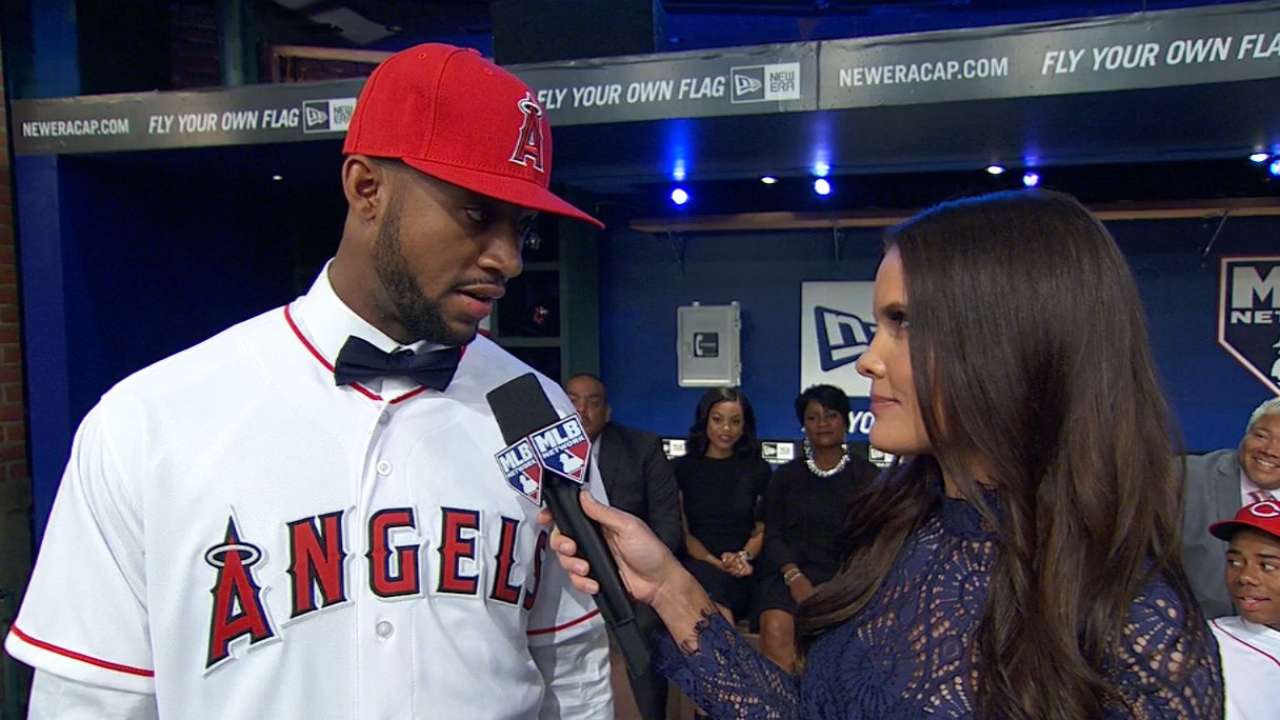
11. Chicago White Sox: 3B Jake Burger, Missouri State University
Callis: He had back-to-back monster seasons at Missouri State and might have the most usable power in this Draft. And while he's not the prettiest-looking player, he gets the job done. He manages the strike zone well, runs better than you think, and he's got a chance to stick at third base.
Callis: He had back-to-back monster seasons at Missouri State and might have the most usable power in this Draft. And while he's not the prettiest-looking player, he gets the job done. He manages the strike zone well, runs better than you think, and he's got a chance to stick at third base.
12. Pittsburgh Pirates: RHP Shane Baz, Concordia Lutheran (Texas) HS
Callis: Baz might have the deepest repertoire in the Draft: He has a mid-90s fastball along with a cut fastball that can be unhittable. The cutter can turn it into a true slider and he can also spin a distinctly different curve, not to mention the makings of the changeup. He is another intriguing two-way player as a power-hitting third baseman, though he's definitely a pitcher as a pro.
Callis: Baz might have the deepest repertoire in the Draft: He has a mid-90s fastball along with a cut fastball that can be unhittable. The cutter can turn it into a true slider and he can also spin a distinctly different curve, not to mention the makings of the changeup. He is another intriguing two-way player as a power-hitting third baseman, though he's definitely a pitcher as a pro.
13. Miami Marlins: LHP Trevor Rogers, Carlsbad (N.M.) HS
Callis: Rogers is a big lefty with a long, loose arm. He's got a low-90s fastball that can hit 95, and his sweeping slider can be tough, especially on lefties, but needs to be more consistent.
Callis: Rogers is a big lefty with a long, loose arm. He's got a low-90s fastball that can hit 95, and his sweeping slider can be tough, especially on lefties, but needs to be more consistent.
14. Kansas City Royals: 1B Nick Pratto, Huntington Beach (Calif.) HS
Callis: Yet another two-way player, as Pratto is also a talented left-handed pitcher, but he'll make his living in the batter's box. He has a sweet, left-handed swing and is the best pure hitter in the high school ranks. The power is starting to come and he's a slick defender at first base as well.
Callis: Yet another two-way player, as Pratto is also a talented left-handed pitcher, but he'll make his living in the batter's box. He has a sweet, left-handed swing and is the best pure hitter in the high school ranks. The power is starting to come and he's a slick defender at first base as well.
15. Houston Astros: RHP J.B. Bukauskas, University of North Carolina
Callis: This could be a tremendous value for the Astros, because Bukauskas looked like he'd go around No. 6 or 7 before he slipped at the end of the season. Both his fastball and slider can be plus-plus pitches at their best.
Callis: This could be a tremendous value for the Astros, because Bukauskas looked like he'd go around No. 6 or 7 before he slipped at the end of the season. Both his fastball and slider can be plus-plus pitches at their best.
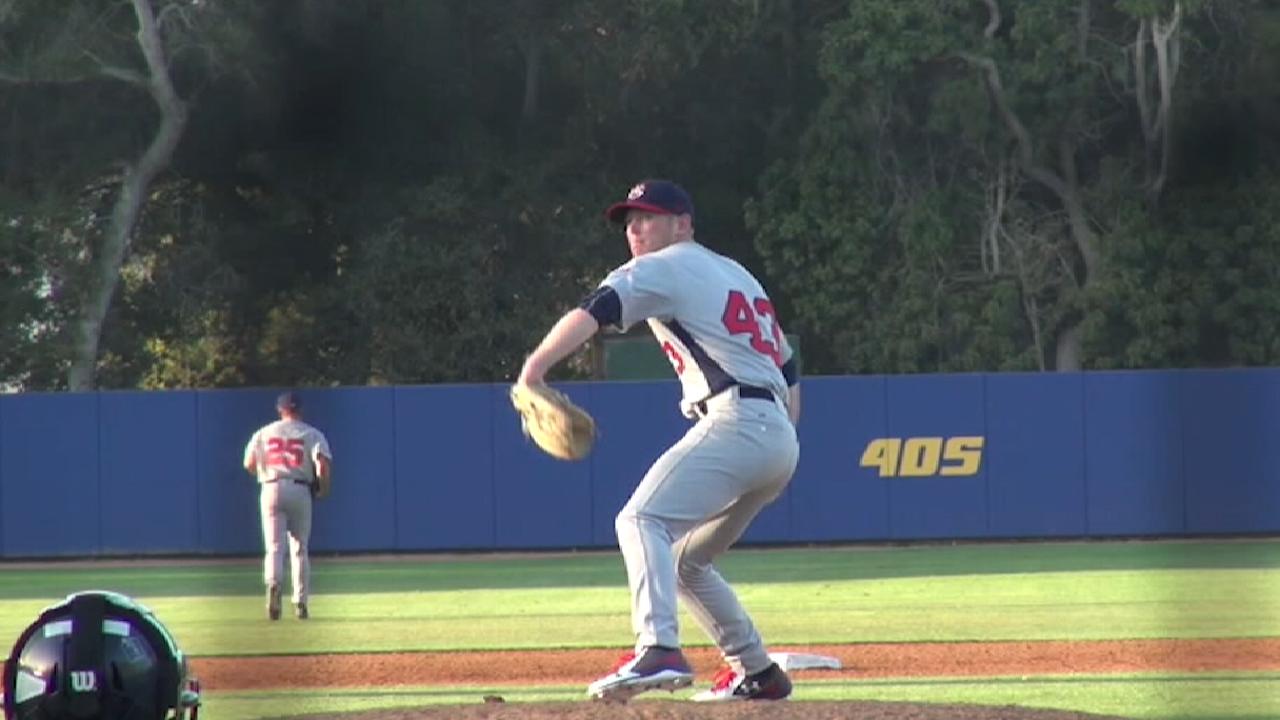
16. New York Yankees: RHP Clarke Schmidt, University of South Carolina
Callis: Interesting to see Schmidt go No. 16, because that's close to the high point of where he would have gone before he had Tommy John surgery this spring. The track record of coming back from elbow reconstruction is good, and Schmidt was one of the top pitchers in the SEC the past two years. He could be a quality starter when he's healthy, but won't throw a pro pitch until 2018. He has a hard sinker and a pair of breaking balls that can both be plus at their best.
Callis: Interesting to see Schmidt go No. 16, because that's close to the high point of where he would have gone before he had Tommy John surgery this spring. The track record of coming back from elbow reconstruction is good, and Schmidt was one of the top pitchers in the SEC the past two years. He could be a quality starter when he's healthy, but won't throw a pro pitch until 2018. He has a hard sinker and a pair of breaking balls that can both be plus at their best.
17. Seattle Mariners: 1B Evan White, University of Kentucky
Callis: White has one of the more interesting profiles in the first round. He's the rare bats-right, throws-left player, and the fact that he's a first-round first baseman whose power is his worst tool makes him even more unusual. That said, he's a solid hitter with plus speed, a good arm and Gold Glove ability at first base. He has the size and bat speed to hit for more power if he modifies his approach. When I ask scouts for comps on him, the best one I got was Cody Bellinger defensively and Stephen Piscotty offensively.
Callis: White has one of the more interesting profiles in the first round. He's the rare bats-right, throws-left player, and the fact that he's a first-round first baseman whose power is his worst tool makes him even more unusual. That said, he's a solid hitter with plus speed, a good arm and Gold Glove ability at first base. He has the size and bat speed to hit for more power if he modifies his approach. When I ask scouts for comps on him, the best one I got was Cody Bellinger defensively and Stephen Piscotty offensively.
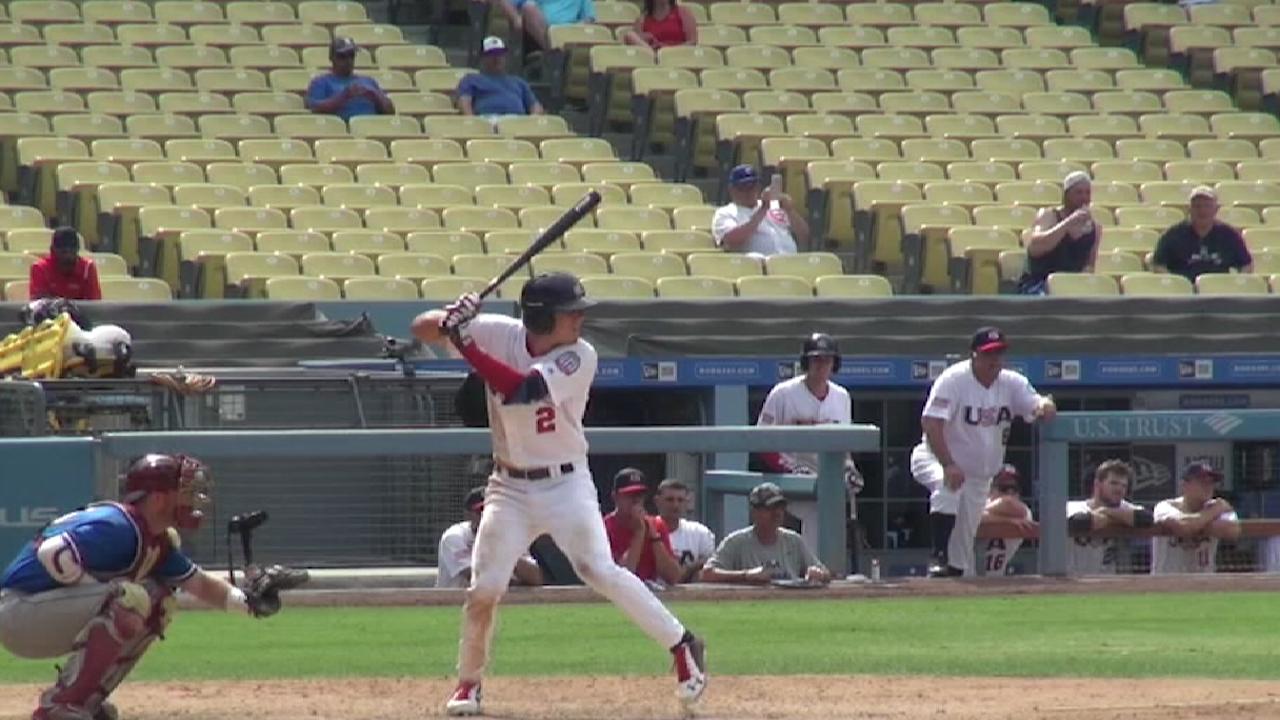
18. Detroit Tigers: RHP Alex Faedo, University of Florida
Callis: The Tigers drafted Faedo in the 40th round out of high school in 2014 and finally get him three years later. Coming into the year, they wouldn't have expected him to fall to them at No. 18, but his fastball dipped into the low 90s for much of the year. He has one of the best sliders in this Draft and could make for a high-leverage reliever if he doesn't pan out as a starter.
Callis: The Tigers drafted Faedo in the 40th round out of high school in 2014 and finally get him three years later. Coming into the year, they wouldn't have expected him to fall to them at No. 18, but his fastball dipped into the low 90s for much of the year. He has one of the best sliders in this Draft and could make for a high-leverage reliever if he doesn't pan out as a starter.
19. San Francisco Giants: OF Heliot Ramos, Leadership Christian Academy (P.R.)
Callis: I saw Ramos put on an absolute show at the Under Armour All-America game at Wrigley Field last summer. He has one of the better power-speed combinations in the Draft, but there are more mixed opinions on him than most of the players taken ahead of him. Some teams saw him as a first-round talent, while others worried about his hitting ability.
Callis: I saw Ramos put on an absolute show at the Under Armour All-America game at Wrigley Field last summer. He has one of the better power-speed combinations in the Draft, but there are more mixed opinions on him than most of the players taken ahead of him. Some teams saw him as a first-round talent, while others worried about his hitting ability.
20. New York Mets: LHP David Peterson, University of Oregon
Callis: Peterson is a polished lefty who took a step forward this season, striking out 20 in a game against Arizona State while ranking among the NCAA Division I leaders in strikeout-to-walk ratio. His low-90s fastball and slider are his two best pitches. He can also mix in a curveball and changeup. I can see him getting quickly to the big leagues as a mid-rotation starter.
Callis: Peterson is a polished lefty who took a step forward this season, striking out 20 in a game against Arizona State while ranking among the NCAA Division I leaders in strikeout-to-walk ratio. His low-90s fastball and slider are his two best pitches. He can also mix in a curveball and changeup. I can see him getting quickly to the big leagues as a mid-rotation starter.
21. Baltimore Orioles: LHP D.L. Hall, Valdosta (Ga.) HS
Callis: I think Hall has the potential to be a great value for the Orioles here at No.21. He's a smaller left-hander who draws comparisons to Scott Kazmir with his low-90s fastball and overpowering curve. Based purely on talent, he could have gone five or so picks higher.
Callis: I think Hall has the potential to be a great value for the Orioles here at No.21. He's a smaller left-hander who draws comparisons to Scott Kazmir with his low-90s fastball and overpowering curve. Based purely on talent, he could have gone five or so picks higher.
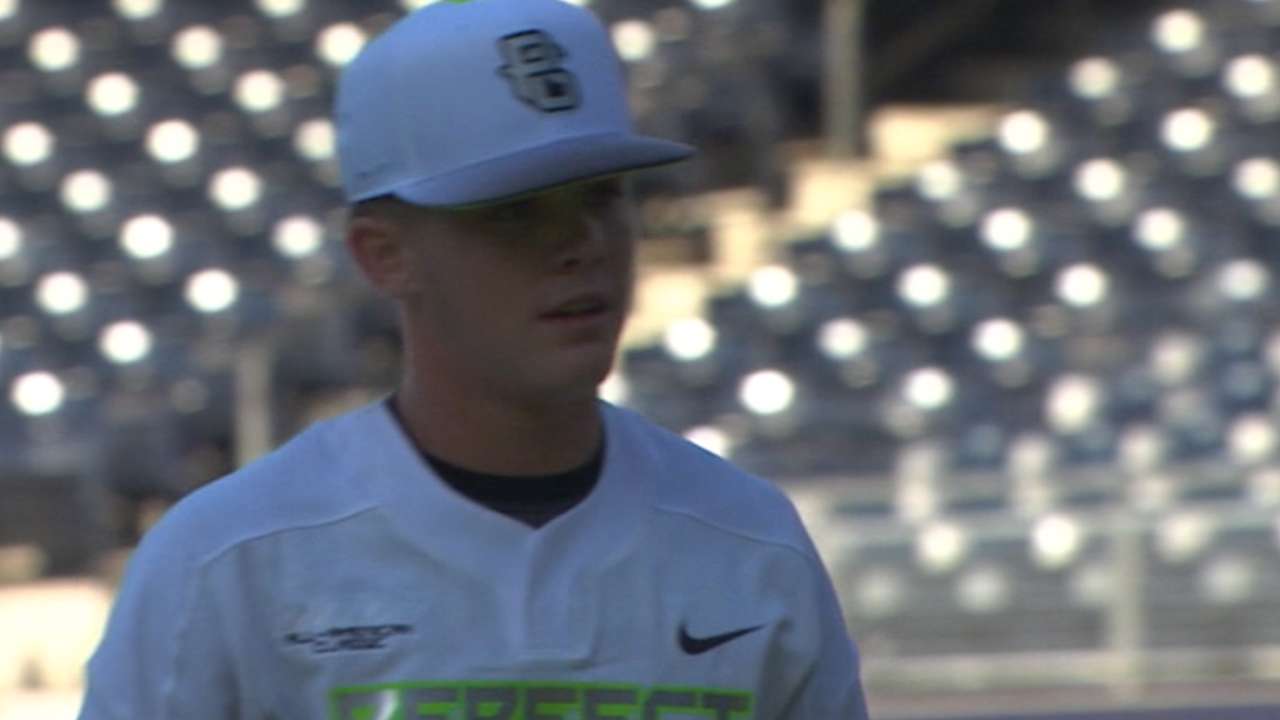
22. Toronto Blue Jays: SS Logan Warmoth, University of North Carolina
Callis: When I was talking to scouts last summer about the best players in the Cape Cod League -- a showcase circuit for college players -- Warmoth's name came up a few times as a sleeper. But he's not a sleeper any longer. In a Draft thin on shortstops at the college level, he was clearly the best, showing advanced hitting skills and potential average tools otherwise across the board.
Callis: When I was talking to scouts last summer about the best players in the Cape Cod League -- a showcase circuit for college players -- Warmoth's name came up a few times as a sleeper. But he's not a sleeper any longer. In a Draft thin on shortstops at the college level, he was clearly the best, showing advanced hitting skills and potential average tools otherwise across the board.
23. Los Angeles Dodgers: OF Jeren Kendall, Vanderbilt
Callis: I know the industry soured on Kendall a bit because of his strikeout rate at Vanderbilt, but I love this pick at No. 23, and personally, would have taken him in the top 10. Yes, he swings and misses, as evidenced by his 74 whiffs in 261 at-bats, but he has the best tools in the college ranks, and he's been a very productive player at a top program. He has a chance to be a 15-HR, 30-steal guy while playing a quality center field.
Callis: I know the industry soured on Kendall a bit because of his strikeout rate at Vanderbilt, but I love this pick at No. 23, and personally, would have taken him in the top 10. Yes, he swings and misses, as evidenced by his 74 whiffs in 261 at-bats, but he has the best tools in the college ranks, and he's been a very productive player at a top program. He has a chance to be a 15-HR, 30-steal guy while playing a quality center field.
24. Boston Red Sox: RHP Tanner Houck, University of Missouri
Callis: Houck looked like a top-10 pick coming into the year, but like a lot of the best college pitchers in this class, his stock dropped a bit. His fastball is tough, 92-96 mph from a low slot, with a lot of action on it. Some scouts think the arm slot and lack of a consistently quality second pitch will make him a reliever, and he could be a weapon in the late innings.
Callis: Houck looked like a top-10 pick coming into the year, but like a lot of the best college pitchers in this class, his stock dropped a bit. His fastball is tough, 92-96 mph from a low slot, with a lot of action on it. Some scouts think the arm slot and lack of a consistently quality second pitch will make him a reliever, and he could be a weapon in the late innings.
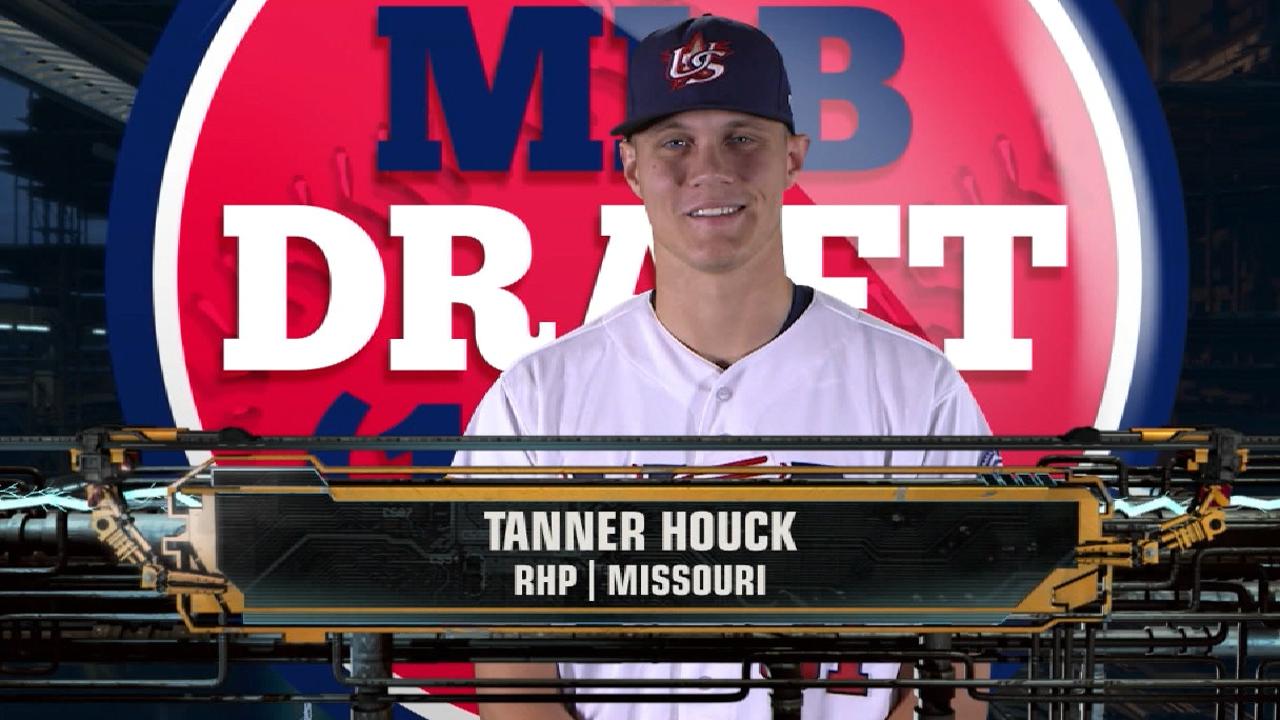
25. Washington Nationals: LHP Seth Romero, University of Houston
Callis: Romero was a no-doubt top-10 pick until he first got suspended and then dismissed from the Houston program this spring. He has a 92-95 mph fastball, a nasty slider, effective changeup and misses a lot of bats. Assuming he can get back on the mound and avoid the trouble that got him kicked off the team at Houston, he can get to the big leagues in a hurry and make an impact.
Callis: Romero was a no-doubt top-10 pick until he first got suspended and then dismissed from the Houston program this spring. He has a 92-95 mph fastball, a nasty slider, effective changeup and misses a lot of bats. Assuming he can get back on the mound and avoid the trouble that got him kicked off the team at Houston, he can get to the big leagues in a hurry and make an impact.
26. Texas Rangers: OF Bubba Thompson, McGill-Toolen (Ala.) HS
Callis: The Rangers are fond of taking high-upside athletes who carry some risk, and Thompson fits that bill. He is a star quarterback who has more baseball aptitude than the typical dual-sport athlete. His well above-average speed and plus arm are his biggest tools, but he also has promising hitting ability and power potential.
Callis: The Rangers are fond of taking high-upside athletes who carry some risk, and Thompson fits that bill. He is a star quarterback who has more baseball aptitude than the typical dual-sport athlete. His well above-average speed and plus arm are his biggest tools, but he also has promising hitting ability and power potential.
27. Chicago Cubs: LHP Brendon Little, State College of Florida Manatee-Sarasota
Callis: Little was a revelation in the Cape Cod League last summer after pitching only four innings as a freshman at UNC. He's a live-armed lefty with a 92-97 mph fastball and a power curve. He needs to refine his control and command to remain a starter, but he could be a dynamic reliever even if he doesn't.
Callis: Little was a revelation in the Cape Cod League last summer after pitching only four innings as a freshman at UNC. He's a live-armed lefty with a 92-97 mph fastball and a power curve. He needs to refine his control and command to remain a starter, but he could be a dynamic reliever even if he doesn't.
28. Toronto Blue Jays (Compensation for Edwin Encarnacion, who signed with the Indians. Cleveland forfeited its first-round pick): RHP Nate Pearson, College of Central Florida
Callis: Pearson has the best fastball in the college ranks this year, and wowed scouts by hitting 102 mph in a recent bullpen workout. His secondary pitches are works in progress, but he can get to the big leagues quickly if deployed as a reliever. He's got the frame and the fastball to make a difference in the late innings.
Callis: Pearson has the best fastball in the college ranks this year, and wowed scouts by hitting 102 mph in a recent bullpen workout. His secondary pitches are works in progress, but he can get to the big leagues quickly if deployed as a reliever. He's got the frame and the fastball to make a difference in the late innings.
29. Texas Rangers (Compensation for Ian Desmond, who signed with the Rockies. Colorado forfeited its first-round pick): SS Christopher Seise, West Orange (Fla.) HS
Callis: Seise stands out in a Draft class that doesn't have many legitimate shortstops. He's not the quickest player at the position, but his instincts and arm allow him to make all the plays. He also shows some promise at the plate with hitting ability and power potential.
Callis: Seise stands out in a Draft class that doesn't have many legitimate shortstops. He's not the quickest player at the position, but his instincts and arm allow him to make all the plays. He also shows some promise at the plate with hitting ability and power potential.
30. Chicago Cubs (Compensation for Dexter Fowler, who signed with the Cardinals. St. Louis forfeited its first-round pick): RHP Alex Lange, Louisiana State University
Callis: The Cubs needed and wanted pitchers and they got two good college arms in the first round in Brendon Little and Lange. Lange was better as a freshman than he has been the last two years, but he's still been the ace of LSU's staff. He has a low-90s fastball, the best college curveball in this Draft, but needs to do a better job of keeping his mechanics in sync and throwing strikes.
Callis: The Cubs needed and wanted pitchers and they got two good college arms in the first round in Brendon Little and Lange. Lange was better as a freshman than he has been the last two years, but he's still been the ace of LSU's staff. He has a low-90s fastball, the best college curveball in this Draft, but needs to do a better job of keeping his mechanics in sync and throwing strikes.
Competitive Balance Round A
31. Tampa Bay Rays: RHP Drew Rasmussen, Oregon State
Callis: Part of a 54-4 Oregon State team that's ranked No. 1 heading into the College World Series, Rasmussen came back this spring from Tommy John surgery. His fastball is clearly his best pitch, sitting at 92-95 when he starts. He has hit 98 in shorter stints. His secondary pitches aren't as strong, so some scouts believe he'll wind up in the bullpen.
31. Tampa Bay Rays: RHP Drew Rasmussen, Oregon State
Callis: Part of a 54-4 Oregon State team that's ranked No. 1 heading into the College World Series, Rasmussen came back this spring from Tommy John surgery. His fastball is clearly his best pitch, sitting at 92-95 when he starts. He has hit 98 in shorter stints. His secondary pitches aren't as strong, so some scouts believe he'll wind up in the bullpen.
32. Cincinnati Reds: SS Jeter Downs, Monsignor Edward Pace (Fla.) HS
Callis: Yes, he's named after Derek Jeter. One of the better shortstops in a down class at the position, Downs has good instincts at the plate and in the field. He can grow into some atypical power for a shortstop.
Callis: Yes, he's named after Derek Jeter. One of the better shortstops in a down class at the position, Downs has good instincts at the plate and in the field. He can grow into some atypical power for a shortstop.
33. Oakland Athletics: SS Kevin Merrell, University of South Florida
Callis: Merrell might have been the fastest player in college baseball this spring. He's a tablesetter with some gap power who has played shortstop and second base at South Florida. He could wind up in center field in the long run.
Callis: Merrell might have been the fastest player in college baseball this spring. He's a tablesetter with some gap power who has played shortstop and second base at South Florida. He could wind up in center field in the long run.
34. Milwaukee Brewers: OF Tristen Lutz, James Martin Senior (Texas) HS
Callis: Lutz has some of the best right-handed power in this Draft. Unlike a lot of high school sluggers, he has advanced hitting instincts that should allow him to translate his power into home runs. The Brewers were rumored to take him as high as No. 9, so they have to be pleased to get him here.
Callis: Lutz has some of the best right-handed power in this Draft. Unlike a lot of high school sluggers, he has advanced hitting instincts that should allow him to translate his power into home runs. The Brewers were rumored to take him as high as No. 9, so they have to be pleased to get him here.
35. Minnesota Twins: OF Brent Rooker, Mississippi State University
Callis: Rooker had the best offensive season of anyone in college baseball, posting a .387/.495/.810 line with 23 homers and 82 RBIs. He poised to win the SEC triple crown, joining Rafael Palmeiro as the only player ever to do that. While the bat and the power stick out the most, he's a good runner and athlete for a big guy (6-foot-4, 215 pounds).
Callis: Rooker had the best offensive season of anyone in college baseball, posting a .387/.495/.810 line with 23 homers and 82 RBIs. He poised to win the SEC triple crown, joining Rafael Palmeiro as the only player ever to do that. While the bat and the power stick out the most, he's a good runner and athlete for a big guy (6-foot-4, 215 pounds).
36. Miami Marlins: OF Brian Miller, University of North Carolina
Callis: Miller had a breakout summer in the Cape Cod League in 2016, and teamed with Logan Warmoth to give UNC two of the best up-the-middle college prospects in this year's Draft. He's a plus runner who puts the bat on the ball and plays a solid center field.
Callis: Miller had a breakout summer in the Cape Cod League in 2016, and teamed with Logan Warmoth to give UNC two of the best up-the-middle college prospects in this year's Draft. He's a plus runner who puts the bat on the ball and plays a solid center field.
ROUND 2
37. Minnesota Twins: RHP Landon Leach, Pickering (Ont.) HS
38. Cincinnati Reds: OF Stuart Fairchild, Wake Forest
39. San Diego Padres: C Luis Campusano-Bracero, Cross Creek (Ga.) HS<
40. Tampa Bay Rays: RHP Michael Mercado, Westview (Calif.) HS
41. Atlanta Braves: OF Drew Waters, Etowa (Ga.) HS
42. Pittsburgh Pirates (Compensation for not signing 2016 No. 41 overall pick Nick Lodolo): RHP Steve Jennings, DeKalb County (Tenn.) HS
43. Oakland Athletics: OF Greg Deichmann, LSU
44. Arizona Diamondbacks: 3B Drew Ellis, University of Louisville
45. Philadelphia Phillies: RHP Spencer Howard, Cal Poly-San Luis Obispo
46. Milwaukee Brewers: RHP Caden Lemons, Vestavia Hills (Ala.) HS
47. Los Angeles Angels: RHP Griffin Canning, UCLA
48. Colorado Rockies: 3B Ryan Vilade, Stillwater (Okla.) HS
49. Chicago White Sox: 1B Gavin Sheets, Wake Forest
50. Pittsburgh Pirates: OF Cal Mitchell, Rancho Bernardo (Calif.) HS
51. Miami Marlins: 3B Joseph Dunand, North Carolina State
52. Kansas City Royals: C MJ Melendez, Westminster Christian School (Fla.)
53. Houston Astros: 3B Joe Perez, Archbishop McCarthy (Fla.) HS
54. New York Yankees: RHP Matt Sauer, Ernest Righetti (Calif.) HS
55. Seattle Mariners: RHP Sam Carlson, Burnsville (Minn.) HS
56. Houston Astros (Pick forfeited by Cardinals, awarded to Astros for breach of Houston's database): RHP Corbin Martin, Texas A&M
57. Detroit Tigers: OF Reynaldo Rivera, Chipola College
58. San Francisco Giants: 3B Jacob Gonzalez, Chaparral (Ariz.) HS
59. New York Mets: 3B Mark Vientos, American Heritage School (Fla.)
60. Baltimore Orioles: SS Adam Hall, A.B. Lucas SS (Ont.)
61. Toronto Blue Jays: C Hagen Danner, Huntington Beach HS
62. Los Angeles Dodgers: RHP Morgan Cooper, University of Texas
63. Boston Red Sox: OF Coleman Brannen, Westfield School (Ga.)
64. Cleveland Indians: OF Quentin Holmes, Monsignor McClancy Memorial (N.Y.) HS
65. Washington Nationals: RHP Wil Crowe, University of South Carolina
66. Texas Rangers: RHP Hans Crouse, Dana Hills (Calif.) HS
67. Chicago Cubs: RHP Cory Abbott, Loyola Marymount University
37. Minnesota Twins: RHP Landon Leach, Pickering (Ont.) HS
38. Cincinnati Reds: OF Stuart Fairchild, Wake Forest
39. San Diego Padres: C Luis Campusano-Bracero, Cross Creek (Ga.) HS<
40. Tampa Bay Rays: RHP Michael Mercado, Westview (Calif.) HS
41. Atlanta Braves: OF Drew Waters, Etowa (Ga.) HS
42. Pittsburgh Pirates (Compensation for not signing 2016 No. 41 overall pick Nick Lodolo): RHP Steve Jennings, DeKalb County (Tenn.) HS
43. Oakland Athletics: OF Greg Deichmann, LSU
44. Arizona Diamondbacks: 3B Drew Ellis, University of Louisville
45. Philadelphia Phillies: RHP Spencer Howard, Cal Poly-San Luis Obispo
46. Milwaukee Brewers: RHP Caden Lemons, Vestavia Hills (Ala.) HS
47. Los Angeles Angels: RHP Griffin Canning, UCLA
48. Colorado Rockies: 3B Ryan Vilade, Stillwater (Okla.) HS
49. Chicago White Sox: 1B Gavin Sheets, Wake Forest
50. Pittsburgh Pirates: OF Cal Mitchell, Rancho Bernardo (Calif.) HS
51. Miami Marlins: 3B Joseph Dunand, North Carolina State
52. Kansas City Royals: C MJ Melendez, Westminster Christian School (Fla.)
53. Houston Astros: 3B Joe Perez, Archbishop McCarthy (Fla.) HS
54. New York Yankees: RHP Matt Sauer, Ernest Righetti (Calif.) HS
55. Seattle Mariners: RHP Sam Carlson, Burnsville (Minn.) HS
56. Houston Astros (Pick forfeited by Cardinals, awarded to Astros for breach of Houston's database): RHP Corbin Martin, Texas A&M
57. Detroit Tigers: OF Reynaldo Rivera, Chipola College
58. San Francisco Giants: 3B Jacob Gonzalez, Chaparral (Ariz.) HS
59. New York Mets: 3B Mark Vientos, American Heritage School (Fla.)
60. Baltimore Orioles: SS Adam Hall, A.B. Lucas SS (Ont.)
61. Toronto Blue Jays: C Hagen Danner, Huntington Beach HS
62. Los Angeles Dodgers: RHP Morgan Cooper, University of Texas
63. Boston Red Sox: OF Coleman Brannen, Westfield School (Ga.)
64. Cleveland Indians: OF Quentin Holmes, Monsignor McClancy Memorial (N.Y.) HS
65. Washington Nationals: RHP Wil Crowe, University of South Carolina
66. Texas Rangers: RHP Hans Crouse, Dana Hills (Calif.) HS
67. Chicago Cubs: RHP Cory Abbott, Loyola Marymount University
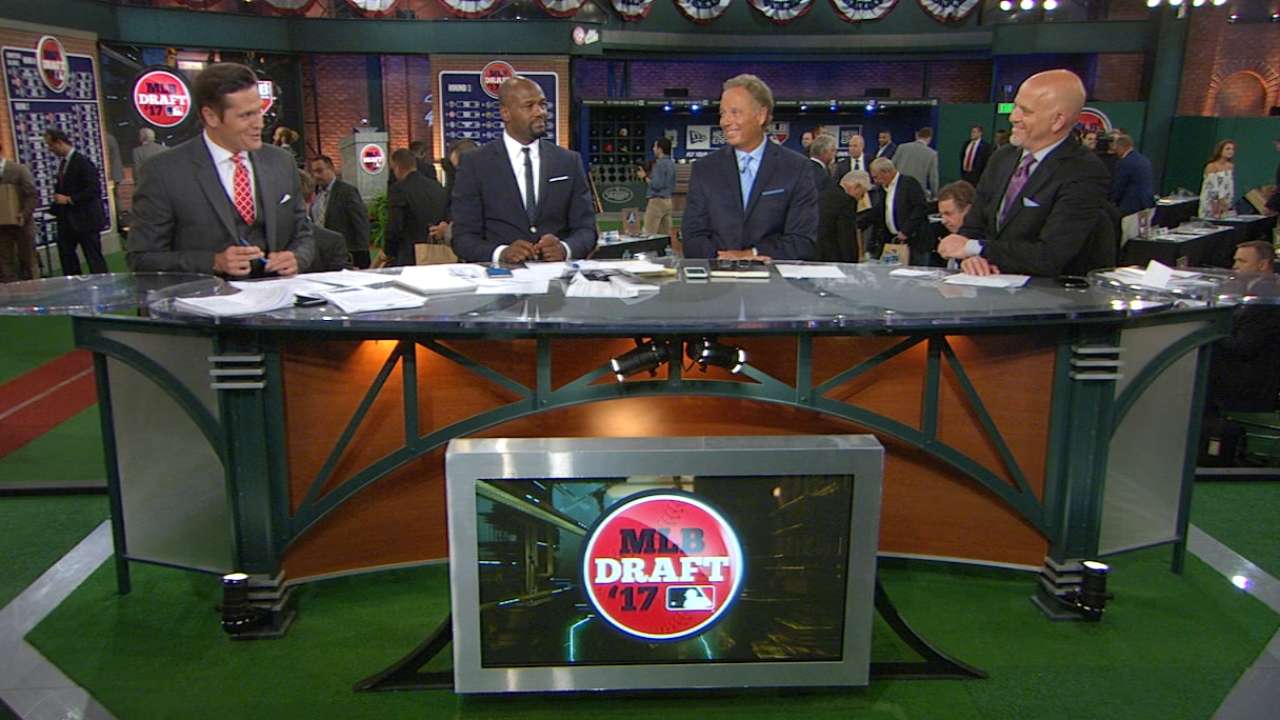
Here's a look at some of my favorite picks from the rest of Day 1.
Steve Jennings is one of my favorite stories in the Draft. He's a star quarterback who tore his ACL in September but was back on the mound this spring. There were times when he showed a plus fastball-slider combination. His other pitches are promising, and he's a good athlete. ... Griffin Canning looked like he'd might even have gone as high as the Angels' first-round pick at No. 10 until some medical concerns arose shortly before the Draft. He's got a solid four-pitch mix and scouts debate whether his fastball, slider, curveball or change is his best pitch. ... You can't talk to a scout about Ryan Vilade without hearing about how great his makeup is. He's a pretty talented player as well. He has good right-handed power and a strong arm that will still play when he makes the expected move from shortstop to third base. He has a long track record of performance on the showcase circuit and in international play with Team USA. ...
The first-round pick of Clarke Schmidt, who is recovering from Tommy John surgery, makes a lot more sense now that we know the Yankees were saving money to get Matt Sauer in the second round. He had a chance to go in the first round after reaching 97 mph with his fastball and backing it up with a power slider this spring. Sauer has a commitment to Arizona, but the Yankees are likely to sign him. ... Sam Carlson might be the steal of the first day. Carlson had the stuff and pitchability to go in the middle of the first round. He can pitch at 93-97 with sink and run and command, and also has a pair of solid secondary pitches in his slider and changeup. ...
Hagen Danner had first-round interest from teams as both a catcher and a right-hander. As a catcher, he has a strong arm and offers plus raw power. On the mound, he can run his fastball to 95 and snap off a plus curveball. ... For a team that didn't get to pick until No. 64, the Indians came away with a nice talent in Quentin Holmes. Holmes is as fast as any player in the Draft, and has a chance to develop into a quality hitter with some gap power.
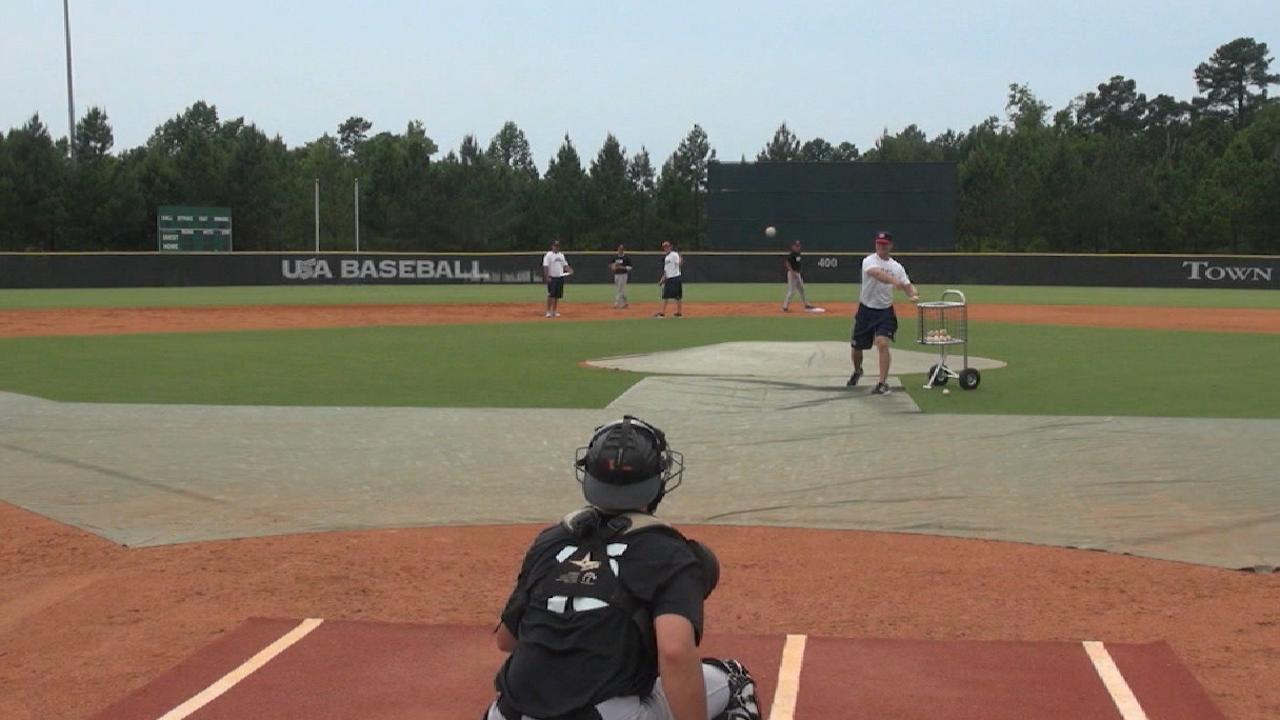
Competitive Balance Round B
68. Arizona Diamondbacks: C Daulton Varsho, University of Wisconsin-Milwaukee
69. San Diego Padres: C Blake Hunt, Mater Dei (Calif.) HS
70. Colorado Rockies: RHP Tommy Doyle, University of Virginia
71. Cleveland Indians: SS Tyler Freeman, Etiwanda (Calif.) HS
72. Pittsburgh Pirates: OF Conner Uselton, Southmoore (Okla.) HS
73. Kansas City Royals: LHP Evan Steele, Chipola College
74. Baltimore Orioles: LHP Zac Lowther, Xavier
75. Houston Astros (Pick forfeited by Cardinals, awarded to Astros for breach of Houston's database): 2B J.J. Matijevic, University of Arizona
68. Arizona Diamondbacks: C Daulton Varsho, University of Wisconsin-Milwaukee
69. San Diego Padres: C Blake Hunt, Mater Dei (Calif.) HS
70. Colorado Rockies: RHP Tommy Doyle, University of Virginia
71. Cleveland Indians: SS Tyler Freeman, Etiwanda (Calif.) HS
72. Pittsburgh Pirates: OF Conner Uselton, Southmoore (Okla.) HS
73. Kansas City Royals: LHP Evan Steele, Chipola College
74. Baltimore Orioles: LHP Zac Lowther, Xavier
75. Houston Astros (Pick forfeited by Cardinals, awarded to Astros for breach of Houston's database): 2B J.J. Matijevic, University of Arizona
The son of former big leaguer Gary Varsho, who named him after his teammate Darren Daulton, Daulton Varsho is an athletic catcher with plus speed and good receiving skills. He shows ability to hit for average and some power, enough so that if his fringy arm forces a move from behind the plate, he might be able to profile in left field. ... A former college football prospect as a quarterback, Conner Uselton gave up the gridiron to focus on baseball. His bat speed, strength and leverage give him tremendous raw power. He showed improved hitting skills this spring. With his cannon arm and solid speed, he's an asset on defense as well.
Jim Callis is a reporter for MLB.com. Follow @jimcallisMLB on Twitter and listen to him on the weekly Pipeline Podcast. This story was not subject to the approval of Major League Baseball or its clubs.
Sent from my iPhone
No comments:
Post a Comment